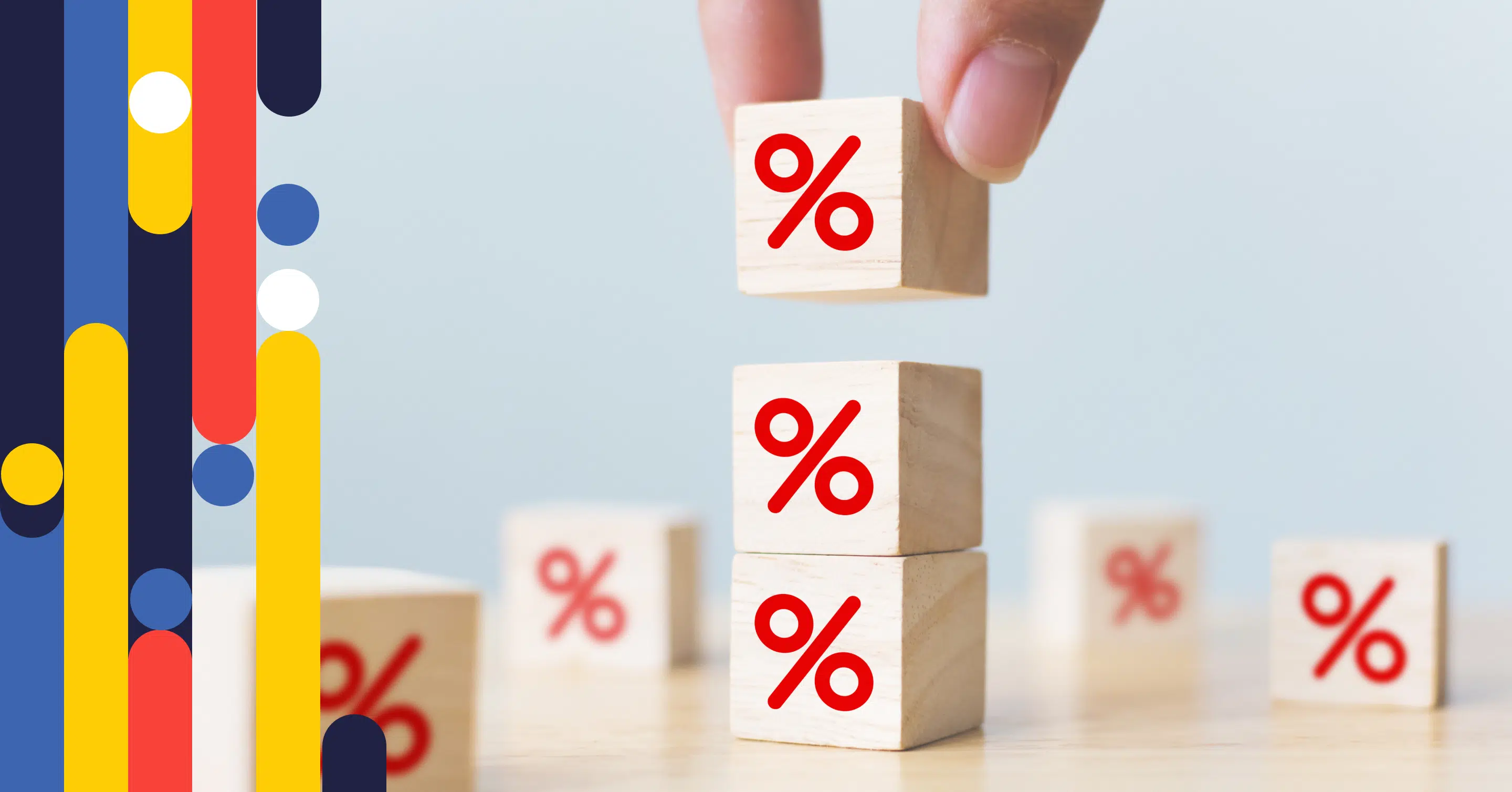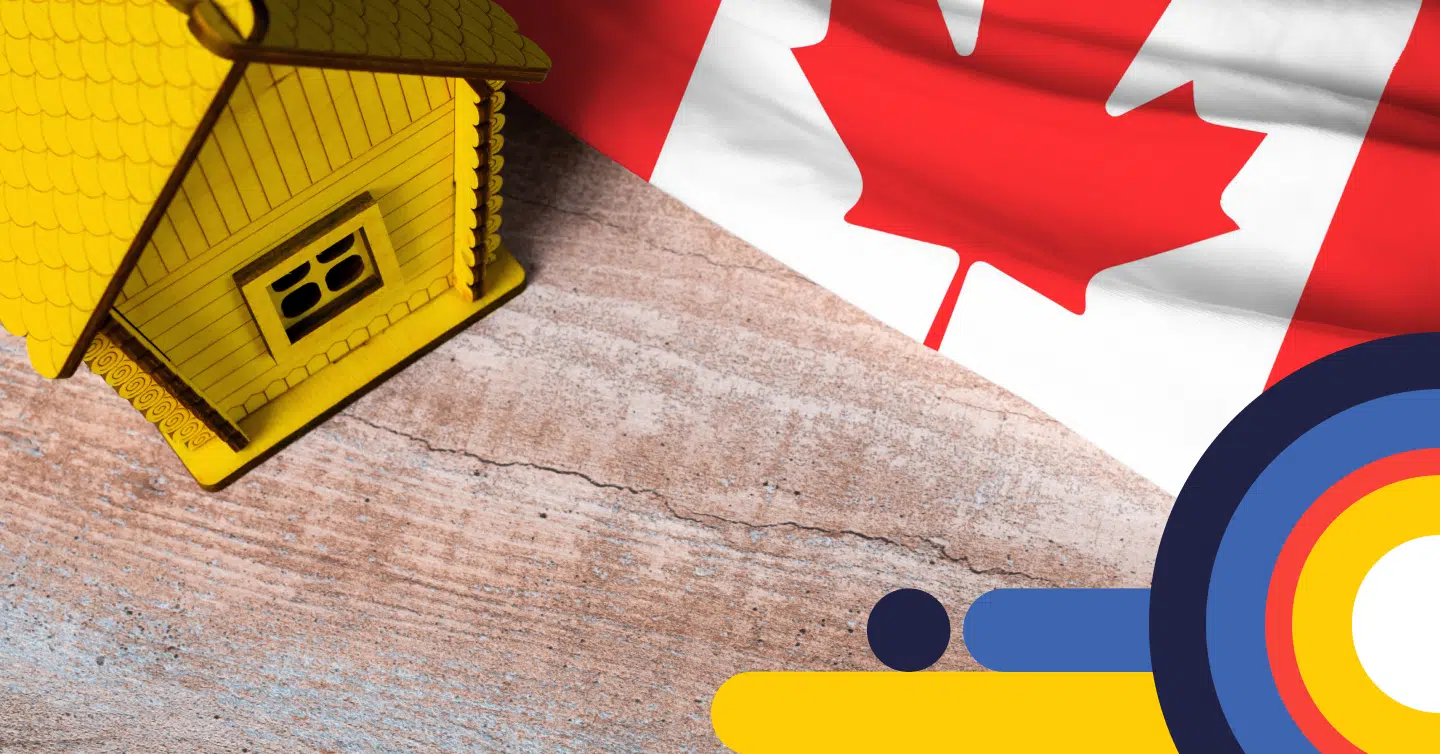Inflation Rate and CPI in Canada Today

Table of contents
You might not need to know how to calculate the inflation rate in Canada yourself, but understanding what inflation is, how it is measured, and what those numbers represent plays a huge part in personal financial planning. Simply put, having a grasp of how inflation works can only benefit your financial decision making in the future.
Key Highlights
- Inflation refers to the rate at which prices for goods and services increase.
- To measure inflation in Canada, we use the Consumer Price Index, or CPI, which looks at the prices of a basket of common goods and services that Canadians typically purchase.
- High inflation benefits borrowers holding fixed interest rates more than variable interest rate holders.
Current Inflation Rate in Canada Today: 3.4%
As of January 2024, Canada’s inflation rate was at 3.4%, an increase from 3.1% in November 2023. The table below shows CPI contributions to the inflation rate in December 2023.
| CPI Category | CPI |
|---|---|
| Food | 5% |
| Shelter | 5.96% |
| Household | -1.67% |
| Clothing | 0.95% |
| Transport | 3.23% |
| Health | 3.67% |
| Recreation | 1.73% |
| Alcohol, Tobacco, and Cannabis Products | 4.3% |
Historical Inflation Rates in Canada
The table below provides a 10-year historical overview of Canadian inflation rates, from January 2013 to December 2023.
| Year | Jan | Feb | Mar | Apr | May | Jun | Jul | Aug | Sep | Oct | Nov | Dec |
| 2013 | 0.50% | 1.24% | 0.99% | 0.41% | 0.74% | 1.15% | 1.32% | 1.07% | 1.07% | 0.65% | 0.90% | 1.24% |
| 2014 | 1.48% | 1.14% | 1.55% | 2.04% | 2.28% | 2.36% | 2.11% | 2.11% | 2.03% | 2.36% | 1.95% | 1.47% |
| 2015 | 0.97% | 1.05% | 1.20% | 0.80% | 0.87% | 1.03% | 1.27% | 1.27% | 1.03% | 1.03% | 1.36% | 1.61% |
| 2016 | 2.01% | 1.36% | 1.27% | 1.66% | 1.50% | 1.49% | 1.26% | 1.10% | 1.34% | 1.49% | 1.18% | 1.50% |
| 2017 | 2.13% | 2.05% | 1.56% | 1.64% | 1.32% | 1.01% | 1.16% | 1.40% | 1.55% | 1.39% | 2.10% | 1.87% |
| 2018 | 1.70% | 2.16% | 2.31% | 2.22% | 2.22% | 2.45% | 2.99% | 2.84% | 2.22% | 2.44% | 1.68% | 1.99% |
| 2019 | 1.44% | 1.51% | 1.88% | 2.03% | 2.40% | 2.02% | 2.01% | 1.94% | 1.87% | 1.86% | 2.17% | 2.25% |
| 2020 | 2.40% | 2.16% | 0.89% | -0.22% | -0.37% | 0.66% | 0.15% | 0.15% | 0.51% | 0.66% | 0.95% | 0.73% |
| 2021 | 1.02% | 1.09% | 2.20% | 3.39% | 3.60% | 3.06% | 3.72% | 4.09% | 4.38% | 4.65% | 4.72% | 4.80% |
| 2022 | 5.14% | 5.69% | 6.66% | 6.77% | 7.73% | 8.13% | 7.59% | 7.01% | 6.86% | 6.88% | 6.80% | 6.32% |
| 2023 | 5.92% | 5.20% | 4.30% | 4.40% | 3.40% | 2.80% | 3.30% | 4.00% | 3.80% | 3.10% | 3.10% | 3.40% |
| 2024 |
Find a better rate, and we’ll match it, beat it, or give you $500*.
*Conditions Apply
With nesto, it’s stress-free
What is Inflation & How Is It Measured?
In short, inflation refers to the rate at which prices for goods and services increase. It’s a phenomenon that reduces our purchasing power over time, which means we won’t be able to buy the same amount of goods and services with the same amount of money in the future as we could in the past. To measure inflation in Canada, we use the Consumer Price Index, or CPI, which looks at the prices of a basket of common goods and services that Canadians typically purchase. The CPI is calculated based on a 12-month percentage change, and it is a key indicator of inflationary pressures in the economy.
Since this data encompasses the entire country, the CPI is calculated proportionately to the population of each region. This means that if the population of Quebec makes up 23% of the Canadian population, 23% of Canada’s CPI basket data will be from Quebec in order to accurately represent the national average.
What Drives Inflation?
One key driver of inflation is the level of demand in the economy. When consumer spending increases, businesses may respond by raising prices to take advantage of the higher demand. This increase in demand can be fueled by factors such as economic growth, low interest rates, and government policies that stimulate consumer spending.
Additionally, inflation can also be influenced by changes in the cost of production. If the cost of raw materials, labor, or other inputs increases, businesses may pass these costs onto consumers in the form of higher prices. This is known as cost-push inflation. Another factor that can contribute to inflation is changes in the money supply. If the central bank increases the amount of money in circulation, it can lead to an increase in spending and demand, which can then drive up prices.
How to Calculate Inflation Rate
Calculating inflation is fairly straightforward. In Canada, we use numbers from the Consumer Price Index (CPI) to calculate changes in prices of different goods and services overtime. Since inflation is calculated on a 12-month basis, the only data you need is the price of a good or a service in the current year and the price of that good or service from the previous year. The formula is also simple:
Inflation = (Price from current year – Price from previous year) / Price from previous year x 100
July 2023 Inflation Rate Calculation
(July 2023 CPI – July 2022 CPI) / July 2022 CPI x 100 = Inflation Rate
158.1 – 153.1 / 153.1 x 100 = 3.27%
Inflation Rates by Province and City
As mentioned, cost of living can differ significantly across the country, between provinces and cities. CPI on regional levels is an important indicator of these differences and is a key comparison tool to gauge cost of living.
Inflation Rates by Province
| Province | Inflation Rate |
|---|---|
| Ontario | 5.63% |
| British Columbia | 6.24% |
| Quebec | 6.24% |
| Alberta | 5.04% |
| Manitoba | 6.91% |
| Saskatchewan | 6.02% |
| Nova Scotia | 6.86% |
| New Brunswick | 6.46% |
| Prince Edward Island | 7.02% |
| Newfoundland and Labrador | 5.48% |
Inflation Rate by Major City
| City | Inflation Rate |
|---|---|
| Toronto | 5.73% |
| Ottawa | 6.02% |
| Vancouver | 5.71% |
| Victoria | 6.51% |
| Calgary | 5.54% |
| Edmonton | 4.26% |
| Montreal | 6.62% |
| Quebec City | 6.41% |
| Winnipeg | 7.08% |
| Regina | 6.01% |
| Saskatoon | 6.14% |
| Halifax | 6.66% |
| Charlottetown | 7.71% |
| Saint John | 6.54% |
| St. John’s | 5.53% |
| Whitehorse | 7.94% |
| Yellowknife | 6.26% |
| Iqaluit | 3.41% |
What is CPI (Consumer Price Index)?
CPI, or consumer price index, is a measure of the average change in prices paid by consumers for goods and services over time. Put simply, it is a way to measure inflation and evaluate changes in the cost of living. The calculation of CPI takes into account a basket of goods and services commonly purchased by households, such as food, housing, transportation, and medical care, to name a few. By tracking changes in the cost of these items, CPI provides important information for policymakers, businesses and consumers alike.
CPI data can also be calculated regionally, by province and territory or even city. In doing so, CPI can be used as a comparative tool for cost of living in different parts of the country.
What are the Standard CPI Categories & How Are They Defined?
The standard CPI categories represent what Canadian consumers are spending on the most each year. These categories are include:
- Food
- Shelter
- Household Operations
- Clothing/Footwear
- Transportation
- Health and Personal Care
- Recreation, Education, and Reading
- Alcohol, Tobacco, and Cannabis Products
CPI Basket Weights (2023)
| Category | CPI Basket Weight |
|---|---|
| Food | 16.65% |
| Shelter | 28.34% |
| Household Operations | 14.36% |
| Clothing and Footwear | 4.7% |
| Transportation | 16.44% |
| Health | 5.03% |
| Recreation | 9.92% |
| Alcohol, Tobacco, and Cannabis Products | 4.53% |
CPI Basket Weights Over Time
The table below depicts the weight of each CPI category over the past decade.
| Categories | 2001 | 2005 | 2009 | 2011 | 2013 | 2015 | 2017 | 2020 | 2021 |
|---|---|---|---|---|---|---|---|---|---|
| Food | 16.89 | 17.04 | 15.99 | 16.6 | 16.41 | 16.23 | 16.48 | 16.24 | 15.94 |
| Shelter | 26.75 | 26.62 | 27.49 | 26.26 | 26.8 | 27.15 | 27.36 | 30.03 | 29.8 |
| Household Operations | 10.58 | 11.1 | 11.55 | 12.66 | 13.14 | 12.97 | 12.8 | 14.89 | 14.5 |
| Clothing/Footwear | 5.37 | 5.36 | 5.31 | 5.82 | 6.08 | 5.44 | 5.17 | 3.99 | 4.31 |
| Transportation | 19.79 | 19.88 | 20.6 | 19.98 | 19.1 | 19.7 | 19.95 | 15.96 | 16.91 |
| Health and Personal Care | 4.52 | 4.73 | 4.95 | 4.93 | 4.73 | 5 | 4.79 | 4.68 | 4.62 |
| Recreation | 11.96 | 12.2 | 11.2 | 10.96 | 10.89 | 10.89 | 10.24 | 9.4 | 9.29 |
| Alcohol, Tobacco, and Cannabis | 4.13 | 3.07 | 2.91 | 2.79 | 2.86 | 2.63 | 3.21 | 4.8 | 4.63 |
Goods vs Services: Which Has a Greater Impact on Inflation?
Historically, goods have been at the forefront of the minds of Canadian consumers and therefore, the Canadian economy. When comparing goods and services, goods have held the majority stake in the CPI basket for decades until the late 1990s.
By the early 2000s, services overtook goods in terms of CPI basket weight, as services came to play a more significant role in the daily lives of Canadian consumers. In fact, up until lockdowns in the midst of the COVID pandemic, the share of services in the CPI basket was growing at a steady pace year over year. And as we learned, since services make up a larger portion of the Canadian CPI, inflation will impact services harder than goods at the present time.
Regional CPI Basket Weights
Pricing of goods and services differs from region to region across the country. As mentioned, in order to paint an accurate picture of inflation in Canada, data is aggregated as proportionately as possible to each province’s population.
| Province or Territory | CPI Basket Weight | % of Population |
|---|---|---|
| Newfoundland and Labrador | 1.30% | 1.36% |
| Nova Scotia | 2.39% | 2.60% |
| New Brunswick | 1.91% | 2.07% |
| Quebec | 20.23% | 22.46% |
| Ontario | 40.46% | 38.81% |
| Manitoba | 3.18% | 3.61% |
| Saskatchewan | 2.84% | 3.07% |
| Alberta | 11.47% | 11.61% |
| British Columbia | 15.67% | 13.66% |
| Whitehorse, Yukon | 0.08% | 0.11% |
| Yellowknife, Northwest Territories | 0.08% | 0.12% |
| Iqaluit, Nunavut | 0.03% | 0.10% |
| Prince Edward Island | 0.37% | 0.43% |
Who Benefits During Inflation?
Borrowers with a fixed interest rate can benefit from inflation, as they are not affected by the resulting rise of interest rates, at least until the end of their loan term. Their debt is then worth less and will be reduced by the time their interest rate rises.
Governments benefit from inflation for a similar reason. The value of their debt is not only loweverd, but their tax revenue also increases.
Who Gets Hurt by Inflation?
If you are a consumer who earns a fixed income or saves their money, inflation negatively impacts your buying power. It’s pretty straightforward: if your earnings stay the same and the money in your savings doesn’t grow enough, your money won’t be worth as much as prices rise.
For borrowers, variable rate holders are affected by increasing interest rates due to high inflation. In the mortgage world, borrowers holding a variable rate might be met by payment shocks as their monthly payments increase and could be at risk of hitting their trigger points.
Frequently Asked Questions
Welcome to our Frequently-Asked Questions (FAQ) section, where we answer the most popular questions designed and crafted by our in-house experts.
How does inflation impact consumers?
Inflation refers to the rate at which the price of goods and services increase and thus, affects the buying power of consumers, especially those with fixed incomes.
What is deflation?
Deflation is the opposite of inflation and refers to a general decrease in prices across an economy. While this might sound like good news for consumers wanting to stretch their budgets, it can actually be a worrying sign for an economy as it can lead to reductions in wages, job losses and business failures. In essence, deflation reflects a lack of demand for goods and services.
What are negative real interest rates?
Negative real interest rates are the result of inflation outpacing nominal interest rates. In essence, this means that the real cost of borrowing is decreasing. Deflation, or a decrease in the general price level of goods and services, can also result in negative real interest rates. This scenario can be a boon for borrowers, as the cost of servicing debt decreases over time.
Ready to get started?
In just a few clicks, you can see our current rates. Then apply for your mortgage online in minutes!
















